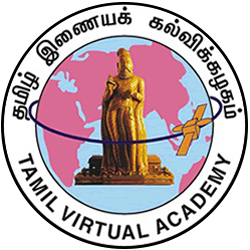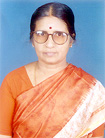T. Janakiraman occupies a pride of place in the
annals of modern creative writing in Tamil. A short story writer,
novelist and playwright, his career has been too prolific as one
to be summed up in a brief introductory write-up. The Tanjore soil
known historically; for its cultural and literary; flavour forms
the settings of his creations. Having been published in such leading
journals and magazines as “Swadesa Mitran”, Kalaki, Dinamani kadir,
Kalaimagal, Kaniyazhi etc., his short stories were brought out as
editions of anthologies later.
Born in தேவன்குடி
village in Tanjore District in 1921 he died as a writer of
renown in 1983. He started writing even as a boy of 17. A trained
graduate teacher, he joined AIR as an Educational Programme Assistant
after a 11-year stint at teaching. After his retirement he came
to edit Kanaiyazhi, a committed literary journal, and had the opportunity
of visiting Japan, Czechoslovakia and America. He has come to be
affectionately called Kottumelam (கொட்டுமேளம்),
Sivappa Ricksha (சிவப்பு ரிக்ஷா),
Akbar Shastry (அக்பர் சாஸ்த்ரி),
Yathum oore (யாதும் ஊரே), Sakthi
Vaithyam (சக்தி வைத்தியம்), Manithabimanam
(மனிதாபிமானம்), are anthologies
of his short stories. His Mohamull (மோகமுள்)
caused a flutter among readers and critics when it appeared and
his marapasu kalam (மரப்பசு, காலம்)
happen to be trend-setters in that particular line of writing.
Naaluveli Nilam (நாலு
வேலி நிலம்,), Vadivelu Vaathiar (வடிவேலு
வாத்தியார்), are his plays and Uthaya Sooriyan (உதய
சூரியன்), Natantai Vaazhi Kaveri (நடந்தாய்
வாழி காவேரி), Karunkatalum Kalai Kadalum (கருங்கடலும்
கலைக்கடலும்) are his travelogues.
Moha Mull (மோக
முள்) was made into an off-beat film. He has been translated
into English, Russian and many Indian languages.
His short story collection Sakthi
Vaithiyam (சக்தி வைத்தியம்) won
the Sahitya Akademi award in 1979. His short stories have especially
ranked him with some of the best known writers of the world.
Men, whether good or bad, great or
small, rich or poor are in the center of his canvas. Ganga Snanm
(கங்கா ஸ்நானம்), Mulmudi (முள்முடி),
Gothavari kundu (கோதாவரி குண்டு),
are stories that reflect the streaks of the apparent and real in
human character. The story Yoshiki (யோஷிகி)
gives his a pen-picture of a Japanese guide who takes him round
on a site-seeing trip in Japan, and who conducts himself with grace
and dignity. Te. Ja’s (தி. ஜா’ s ),
characters are in the main emotional creatures guided by their jealousies,
loves, hates, often tossed between their responsibilities and preferences.
Te. Ja’s (தி,
ஜா ‘s) characterization offers; us a multi-hued spectra of
women and men who include sadhus, women of easy virtue, beggars,
and freaks. Critics often have been able to find his women desire-prone,
self-indulgent. and deeply conscious of their sex appeal.
His is a style extraordinarily crisp
and poignantly; expressive and the diction so natural that it allows
the characters to speak a living language. Akbar shasthri (அக்பர்
சாஸ்த்ரி) is a master where his characterization and use
of language are concerned.
The soil of Tanjore district forms
the setting of his stories and the entire gamut of his narration
exudes the flavour of the soil and his involvement with it.
On the whole,Te. Ja’s (தி, ஜா ‘s)
fiction is a realistic picturization of life in all its variety-the
dipping joy in cauvery, the aroma of the wet and dry fields, the
special brew of filtered coffee, the betel-nut-tobacco blend-all
add to the creative beauty of his work and the metaphorical sequence
of his verbal texture includes a fine thread of humor too.
Te. Ja’s (தி, ஜா ‘s) many-splendoured
personality finds its identity in his creative art.


